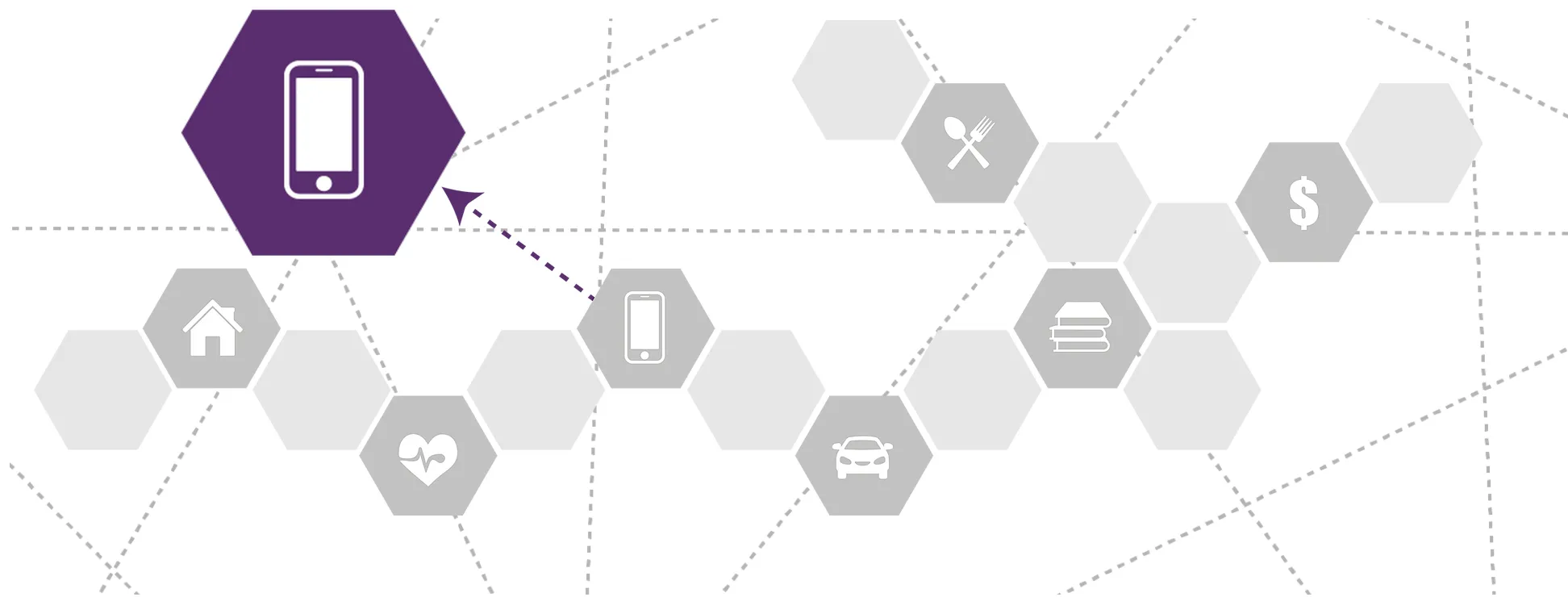
|
Housingclick to view |

|
Health Careclick to view |

|
Child Care and Educationclick to view |

|
Technologyclick to view |

|
Foodclick to view |

|
Taxesclick to view |

|
Transportationclick to view |
||
Future Trends: ALICE Online
Basic technology will continue to improve and be faster and cheaper. As that happens, the digital divide for the most basic services — like smartphones and home internet — will continue to shrink.
The introduction of newer, more advanced, and costly technologies will add capabilities but also costs for consumers. Technologies will add entertainment options for families -- including smart televisions or digital voice assistants – but will also offer safety enhancements like household thermostats and security systems or wearable devices for health and wellness. They will add monetary cost as well as the time it takes to learn about a new product or process, cancellation fees, and psychological effort and time to implement and incorporate it into their lives. ALICE families especially will not have the time or funds to adopt these new technologies and the gap in health and access to information will grow wider.43
More jobs require technology. In the face of rapidly rising computing power, an ability to work with data and make data-based decisions will become an increasingly vital skill even within maintainer jobs, so ALICE workers will need new skill sets. With increased mechanization, many jobs will require working alongside machines as well as building and repairing them. The McKinsey Global Institute estimates that in 60 percent of all occupations, an average of 30 percent of work activities are automatable, and therefore more workers will be required to work alongside machines.44
The gig economy will continue to grow, placing more demands on technology and remote work opportunities. Nationwide, there are an estimated 56.7 million freelancers, an increase of 3.7 million over the past five years. Americans are also spending more time freelancing, with an increase in 72 million hours, on average, from 2015 to 2018. Freelancers rely on technology for finding and doing work. In 2018, 68 percent of freelancers reported that they found work online (a 22-point increase from 2014). These trends are expected to continue in the coming years, increasing the demand for innovation and expansion in the tech industry.45
Technology with change safety risks and benefits for many ALICE workers. Advances in technology offer new means to provide safety benefits through monitoring and measurement, such as minimizing exposure to hazardous materials and increasing quality control. For those working outside of regulated companies, such as many gig-economy workers, traditional worker safety protections are not applicable, exposing workers to risks. For ALICE consumers and patients, technology can improve public safety by automating processes to reduce human error such as in long-distance driving and emergency response.46
The health care industry will increasingly rely on mobile health technology. This trend has the potential to cut costs for health care providers, employers, and consumers. For example, for hospitals, retaining qualified health professionals on-site can be expensive, especially in rural areas. Mobile health technology can facilitate the sharing of health staff across hospital systems, thus cutting costs.47 For employers, telemedicine could provide more than $6 billion in savings to U.S. companies as a feature of their employee health plans.48 For consumers, access to mobile health services cuts down on transportation costs, saves time, provides improved access to providers, and helps people avoid using more expensive health care options, like the emergency room (which is used more frequently by low-income people for non-urgent, routine care). Digital health services have also been shown to improve health outcomes, including a decrease in blood glucose levels, diabetes-related eye diseases, hospitalizations, and blood pressure.49 However, ensuring that these benefits can reach all Americans will require the closing of the digital divide and more widespread access to mobile health technology via health plans and health providers.
Sources
43
Anderson, M. (2019, May 7). Digital divide persists even as lower-income Americans make gains in tech adoption. Pew Research Center. Retrieved from https://www.pewresearch.org/fact-tank/2017/03/22/digital-divide-persists-even-as-lower-income-americans-make-gains-in-tech-adoption/
Klemperer, P. (1987, May). Markets with consumer switching costs. The Quarterly Journal of Economics, 102. Retrieved from https://academic.oup.com/qje/article-abstract/102/2/375/1931195?redirectedFrom=fulltext
Zhang, Y., Chen, X., Zhao, Y., & Yao, Q. (2014). Exploring the impact of switching costs on customer retention in the technology standard competition market. Journal of Service Science and Management, 7. Retrieved from https://file.scirp.org/pdf/JSSM_2014081315562903.pdf
Hitlin, P. (2018, September 28). Internet, social media use and device ownership in U.S. have plateaued after years of growth. Pew Research Center. Retrieved from https://www.pewresearch.org/fact-tank/2018/09/28/internet-social-media-use-and-device-ownership-in-u-s-have-plateaued-after-years-of-growth/
44
Manyika, J. (2017, May). Technology, jobs, and the future of work. McKinsey Global Institute. Retrieved from https://www.mckinsey.com/featured-insights/employment-and-growth/technology-jobs-and-the-future-of-work
45
Upwork & Freelancers Union. (2018). Freelancing in America 2018. Retrieved from https://www.upwork.com/i/freelancing-in-america/2018/
46
McKinsey Global Institute. (2017, January). A future that works: Automation, employment and productivity. Retrieved from https://www.mckinsey.com/~/media/McKinsey/Global%20Themes/Digital%20Disruption/Harnessing%20automation%20for%20a%20future%20that%20works/MGI-A-future-that-works_Full-report.ashx
Eden, P., & Gaggl, M. (2015, November 12). On the welfare implications of automation (Policy Research Working Paper No. 7487). Washington, DC: World Bank Group. Retrieved from http://documents.worldbank.org/curated/en/2015/11/25380579/welfare-implications-automation
Freelancers Union & Upwork. (2017). Freelancing in America: A national survey of the new workforce. Retrieved from https://s3.amazonaws.com/fuwt-prod-storage/content/FreelancingInAmericaReport-2017.pdf
U.S. Government Accountability Office. (2015, April 20). Contingent workforce: Size, characteristics, earnings, and benefits. GAO-15-168R. Retrieved from http://www.gao.gov/assets/670/669766.pdf
47
Bloomfield, S. (2017, March 31). The future of rural America includes healthcare access. Broadband Beat, NTCA–The Rural Broadband Association. Retrieved from https://ceoblog.ntca.org/the-future-of-rural-america-includes-healthcare-access/
Schadelbauer, R. (2017). Anticipating Economic Returns of Rural Telehealth. The Rural Broadband Association. Retrieved from https://www.ntca.org/sites/default/files/documents/2017-12/SRC_whitepaper_anticipatingeconomicreturns.pdf
48
Willis Towers Watson. (2014, August 11). Current telemedicine technology could mean big savings. Retrieved from https://www.towerswatson.com/en/Press/2014/08/current-telemedicine-technology-could-mean-big-savings
49
Claxton, G., Sawyer, B., & Cox, C. (2019, January 22). How does cost affect care? Kaiser Family Foundation. Retrieved from https://www.healthsystemtracker.org/chart-collection/cost-affect-access-care/#item-start
Northwest Regional Telehealth Resource Center. (2019). The benefits of telehealth. Retrieved from https://www.nrtrc.org/telehealth-topic-20
Varma, N., & Ricci, R. P. (2015, September 3). Impact of remote monitoring on clinical outcomes. Journal of Cardiovascular Electrophysiology, 26, 1388–1395. Retrieved from https://onlinelibrary.wiley.com/doi/abs/10.1111/jce.12829
Federal Communications Commission. (2018). Promoting telehealth for low-income consumers: FCC seeks comment on launching connected care pilot program. Docket No. 18-213. Retrieved from https://www.fcc.gov/document/fcc-seeks-comment-launching-connected-care-pilot-program

